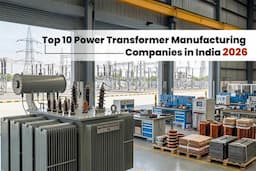What Has Been the Progress in Building the Utilites Infrastructure in India till Now in 2023?
There are 4 sub-sectors of utilities across which India has experienced significant growth, namely: non-renewable energy, renewable energy, water resources, and waste management. India has an installed thermal power capacity of 230 GW, as of 2023 and is well on its way to transitioning towards net zero carbon emissions by 2070. With an installed solar PV capacity of 64 GW, India has become one of the world’s largest producers of solar power. Initiatives like the “One Sun One World One Grid” aim to establish a global interconnected solar grid. Here’s an insight on the opportunities available for building India’s utilities infrastructure and ideas on the supply chain that EPC companies will need.
What Are the Major Opportunities for EPC Infrastructure Companies in the Utilities Sector?
- Opportunities for EPC Infrastructure Companies in Non-Renewable Energy
In the non-renewable energy space, there are 20 projects worth INR 94185 crores under conceptualization. There are 20 non-renewable energy projects worth INR 35659 crores under development. Further, there are 39 projects worth INR 215000 crores which are under implementation.
- Opportunities for EPC Infrastructure Companies in Renewable Energy
In the renewable energy space, there are 17 projects worth INR 18305 crores under conceptualization in the National Infrastructure Pipeline. Further, there are 54 projects worth INR 1152000 crores under development and 73 projects worth INR 176000 crores under implementation.
- Opportunities for EPC Infrastructure Companies in Irrigation
The National Infrastructure Pipeline has 75 projects worth INR 267000 crores under conceptualization in the irrigation space. Further there are 100 projects worth INR 121000 crores under development and 319 projects worth INR 692000 crores under implementation.
- Opportunities for EPC Infrastructure Companies in Waste Management
There are 20 projects worth INR 23857 crores under conceptualization in the waste management space under the auspices of the National Infrastructure Pipeline. Moreover, there are 78 projects worth INR 325000 crores under development and 339 projects worth INR 455000 crores under implementation.
What Supply Chain Solutions Do EPC Infrastructure Companies Need to Leverage Opportunities in the Utilities Sector?
- Granular Approach Towards Custom Manufacturing and Fabrication
As we continue to build infrastructure assets for energy (renewable and non-renewable), irrigation, drinking water, and waste management, EPC infrastructure enterprises are demanding greater throughput of custom manufactured structures.
Typically, large custom manufactured structures are prone to risks of fitment issues. There are also issues of misalignment with specifications mentioned in the design & drawing that can adversely impact the quality of the infrastructure asset and user experience.
It is critical to bulk-break the requirement of a large-sized fabricated structure into small components. Bulk-breaking a project into smaller components offers several benefits. First, it allows for workload distribution among workshops. Second, it allows precision engineering with the existing set of resources. Third, a granular approach to custom manufacturing enables agile quality assurance and greater probability of course correction.
- Agile Procurement for Transmission & Distribution Projects
As India rushes to achieve its net zero emission milestones, the energy sector is poised for major changes. Independent power producers are already demanding faster execution of projects from subcontractors.
A significant consequence of the increase in demand for faster execution of energy projects is the need to fast-track procurement. Be it module mounting structures, balance of supplies, or construction raw materials like TMT steel bar, there is a need to cut slack across the supply chain journey.
Some of the ways to cut slack without compromising on quality and costs include the use of digital procurement solutions, fintech solutions for on-demand credit, and digital project management for fabrication. Business process reengineering methods like vendor consolidation, freight consolidation, and robotic process automation for non-strategic tasks.
- Credit Support and Payment Cycle Standardization for Suppliers
A significant barrier to the agile execution of infrastructure projects is the variability of payment cycles. The absence or lack of on-demand credit support for suppliers increases the turnaround time of order-to-delivery cycles.
One way to reduce the order-to-delivery cycle is to standardize the payment cycle and credit terms. Any deviation from the established timelines for accounts receivable should be mapped to on-demand credit support against a cost-of-credit.
The treasury in such cases may be the EPC project developer or the sub-contractor of the infrastructure project. Advantages of early payments to the EPC project developer or subcontractor include faster execution of purchase orders, fast-tracking of project execution, and incentives from government agencies for before-time completion.
Here’s a use case on how standardization of credit terms and working capital support can enable faster annual turnover growth of EPC project developers in the infrastructure sector in India.
- Pan- India Site Aggregation for Multi-Site Infrastructure Projects in the Operations Stages
Several infrastructure companies, especially in the utilities sub-sector organize their supplier bases on the conventional wisdom of ‘category expertise’. It leads infrastructure companies into relying on at least one supplier per category.
How does the category expertise led supplier selection and procurement affect infrastructure projects?
First, individual suppliers are responsible for the quality, cost, and on-time delivery of their respective categories only.
Corporate leaders of infrastructure companies are however accountable for completing one or more projects on time, not for completing one or more tasks on time.
Second, there are several tasks and resources in the supply chain that cross each other at multiple junctures in the operational stage of infrastructure projects. Individual suppliers are not accountable for mapping resource and task dependencies of an infrastructure company.
At any point in time, a large infrastructure company in the bracket of an annual turnover of INR 7000 crores or more, has not just one, but multiple projects going on at the same time.
Vendor consolidation at each project site makes one procurement partner accountable for the on-time completion of the entire project. Further, a pan-India site aggregation model for multiple infrastructure project sites puts the responsibility of the on-time completion of several projects on the shoulders of one procurement partner.
However, pan India site aggregation for multiple infrastructure projects can work only when the following thumb rules are satisfied.
First, the pan India procurement partner needs to have a very large-scale catalog of categories and SKUs.
Second, the procurement partner must have a digitally integrated supply chain ecosystem of several suppliers to enable fast allocation of resources, purchase orders, and logistics.
Third, the procurement partner must have a thorough understanding of the bill of quantities and an approved vendor list for each project.
Further, the procurement partner must be willing to sign on the dotted lines of SLAs as per the construction schedule and map the task and resource dependencies of suppliers as per the task and resource dependencies of the infrastructure company.
Here’s a successful use case of pan India site aggregation in the utilities sub-sector by a waste management EPC enterprise across 75 sites.
The Catalog for EPC Project Developers and Sub-Contractors That Are Building India’s Utilities Infrastructure
Moglix offers a comprehensive catalog of construction raw materials procurement, indirect procurement, and custom manufacturing solutions to EPC project developers and sub-contractors.
To know more about opportunities in the utilities sub-sector in India’s National Infrastructure Pipeline, download our e-book “Building India: The Infrastructure We Aspire for and the Supply Chain We Need, Second Edition.”




